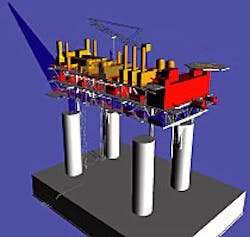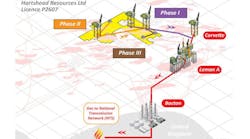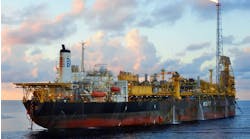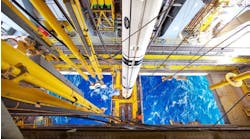Brown & Root designing gravity storage base
This 3D CAD model shows the Malampaya Platform as currently designed by Brown & Root Energy Services. The foundation and the four shafts comprise the concrete gravity substructure. The three-level deck is shown with all major equipment in place. On the left, extending beyond the platform is the 80-meter flare boom [13,946 bytes].Contract awards are moving ahead on Shell's deepwater Malampaya project offshore The Philippines. The project will consist of deepwater wells producing to a shallow water structure, before pipelining to onshore power generating facilities.
Recently, Brown & Root Energy Services was awarded the design, procurement, fabrication, installation and commissioning contract for the Malampaya shallow water processing platform by Shell Philippines Exploration B.V. In turn, Brown & Root Energy Services has issued a letter of intent to the Malampaya CGS Alliance, consisting of John Holland, Arup Energy, and Van Oord ACZ, for the engineering, procurement, construction and installation of the Malampaya concrete gravity substructure.
The Malampaya development will supply natural gas to power plants within the Republic of the Philippines, beginning in October, 2001. The concrete gravity substructure will be located in about 43 meters water depth 50 kilometers west of Palawan Island in the Philippines. It will consist of a rectangular base caisson measuring 112 meters by 70 meters on plan and 16 meters high.
Storage base
The structure will have four shafts extending 15 meters above water level to provide support to a deck having an operational weight of 13,000 tons. In addition to providing deck support, the CGS will be used for temporary storage of up to 385,000 bbl of condensate produced from the subsea wells located 30 km away in about 850 meters water depth.The design capacity of the integrated CGS and deck is 508 MMcf/d of gas and 32,800 b/d of stabilized condensate. The processed gas will be compressed and exported through a 500-km pipeline to the Batangas onshore facility at Luzon Island in The Philippines. The condensate will be stabilized on the deck, stored in the CGS and then exported to a shuttle tanker through a catenary anchored leg mooring system located three km from the platform.
In total, the CGS will contain some 66,000 tons of concrete, 7,100 tons of reinforcing steel, and 600 tons of pre-stressing steel strands. The unit will be fully constructed in the drydock, then floated out and towed to site. Construction of the drydock began in October 1998. Construction of the structure begins in March 1999. The structure is scheduled for installation offshore on a prepared seabed by September, 2000.
Prepared foundation
There are three unusual features of the gravity base structure:- The unit will be the first to be placed on a pre-prepared foundation, which accommodates the uneven seabed.
- The structure will also be constructed to resist earthquake loadings.
- It will be designed such that it can be re-floated at the end of its operational life for environmentally responsible de-commissioning.
The CGS subcontract will be the single biggest value subcontract placed by Brown & Root Energy Services under its Malampaya platform contract. The structure will be constructed in a purpose-built drydock located in Subic Bay, Republic of The Philippines and will be the first structure of this type to be constructed in The Philippines.
Copyright 1998 Oil & Gas Journal. All Rights Reserved.




